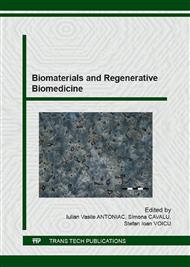p.170
p.178
p.185
p.189
p.196
p.200
p.205
p.215
p.222
Value of Dural Patches in Obliteration of Cranio-Ethmoidal Traumatic CSF Fistulas
Abstract:
During traumatic events or neurosurgical interventions abnormal communications between the CSF-containing subarachnoid space and other extradural spaces may occur and CSF fistulas may develop. As non-traumatic lesions, CSF fistulas are some of the most severe complications of spinal (LDH, extradural and intradural tumors, intramedular tumors) and cranial (cranio-durocerebral tumors, intracranial meningioma, cerebral tumors, vascular malformations of the brain) neurosurgery. There are four types of materials used for dural defects repair: autogenic (from the same patient`s body, usually the fascia lata, periosteum, temporalis fascia or the gales are preferred for cosmetic and morbidity reasons), allogenic (the graft originates from another human), xenogenic (the graft originates from a different species like bovines or pigs) or alloplastic (the graft is inorganic). Biomaterials used as dural substitutes are used to prevent CSF leaks and fistulas and allow the surgeon to make openings in the dura which will heal postoperatively. Dural substitutes can be either biological or synthetic, and are applied just by simple positioning or by suturing them to the defect. The authors consider that prevention of CSF fistulas by using biomaterials similar to the structure of the meninges should be used more frequently and widely, as soon as possible, due to their impact on limiting complications in neurosurgery.
Info:
Periodical:
Pages:
196-199
Citation:
Online since:
May 2016
Authors:
Keywords:
Price:
Сopyright:
© 2016 Trans Tech Publications Ltd. All Rights Reserved
Share:
Citation:


